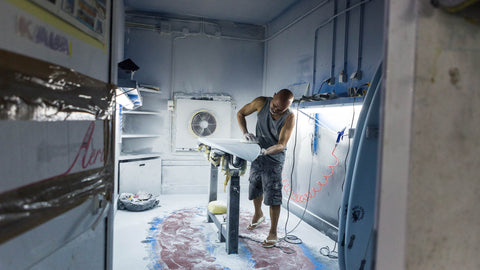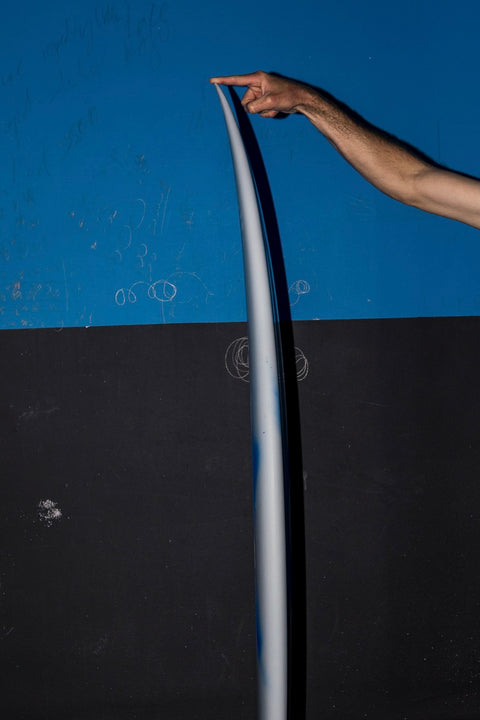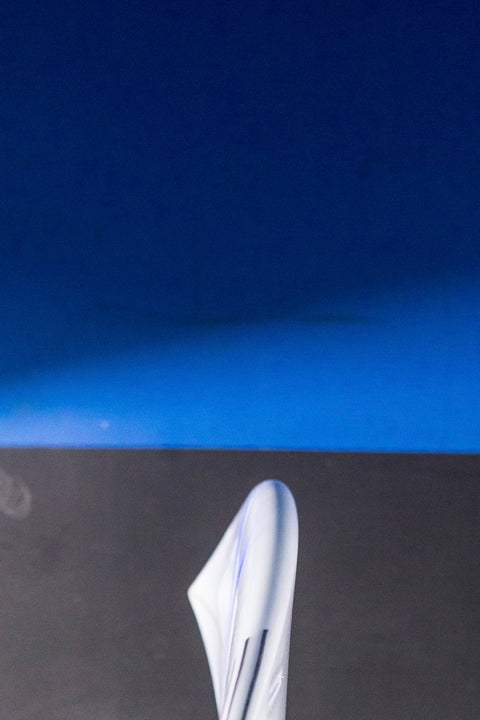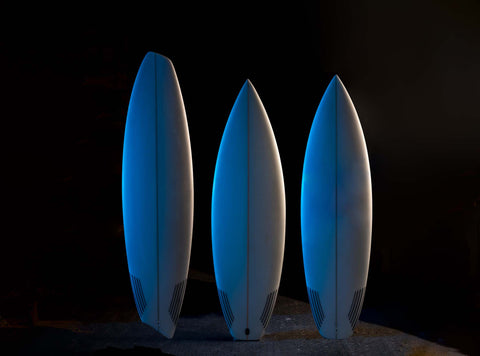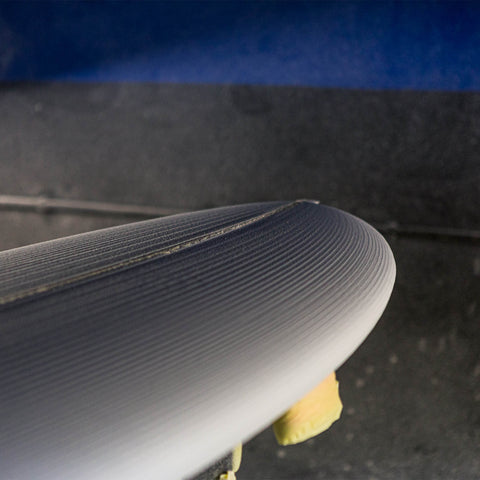Learn About Surfboard Design

Below, we'll explore those elements and the widely accepted theories behind them. Keep in mind: Surfboards have always been tested experientially, not empirically. Plus, many breakthroughs came from individuals going against the conventional wisdom of their time. The cool thing about designing your own custom board is that you get to choose which beliefs you subscribe to — and which standards you’ll violate.
What
The outline of a surfboard.
Generally Speaking
More curve = more maneuverability, less speed.
Surfboard models with pre-set shapes might seem like a modern phenomenon, but they stem back to surfing’s earliest days. In ancient Hawaii, common boards like the Olo, Alaia, and Paipo all had different shapes and were surfed in different ways.
When designing your custom surfboard, you’ll first need to consider the wide point of your shape. A wide point further up — closer to where your chest will be when you lay on the board — is better for paddling and typically makes the board feel more stable on a wave. A bit further back should make it more maneuverable.
You’ll also need to think about the curves on the board as it extends from the wide point to the nose and tail. A board with more curve — especially towards the tail — should be more maneuverable as it will match the curve of a wave and allow you to fit into tighter sections on a wave, but will carry less speed. Less curve should have the opposite effect: more speed and less maneuverability.
What
The bottom end of a surfboard.
Generally Speaking
More angular tail = more control, less drive.
When you’re on a wave, the tail is the last point at which your surfboard interacts with the water. Therefore, different tail shapes have noticeably different performance characteristics. A rounder tail will feel more stable and roll more easily from rail to rail. A sharper tail — like a swallow tail or a square tail — will feel like it has a bit more bite.
The wider the tail, the faster the board will be. Conversely, a more pulled-in tail will make a board more maneuverable at the expense of down-the-line speed.
What
The dimensions of a surfboard — including height, width, thickness and volume.
Generally Speaking
More volume = easier paddling, more stability and less maneuverability.
The three most important things to consider when choosing a surfboard size are your weight, your skill level, and the waves you intend to surf.
Fortunately, we’ve got a formula (based on data from over a thousand surfers) to help you nail the perfect size for your weight and skill level. So, let’s talk about how to design your custom surfboard based on the surf conditions you’ve got in mind.
Bigger waves tend to move faster. So, in order to catch a bigger wave, you’ve got to generate more speed while paddling — and foam is your friend here. A longer, more voluminous board will give you more paddling power and more control in heavier surf.
But here’s where things get interesting: Small wave boards also feature more volume. This is because a more voluminous board is better at generating and carrying speed — which is essential when the waves lack power. However, note that the added volume in small wave boards is often counteracted by other design elements — like a reduced height — to keep the board maneuverable.
What
The curvature of a surfboard's bottom from nose to tail.
Generally Speaking
More rocker = less speed, more maneuverability.
Continuous rocker refers to an uninterrupted curve from nose to tail. It's commonly employed on boards made for high-performance surfing and/or punchier conditions — as the curve allows the board to fit into the steeper parts of a wave.
When a flat section of rocker exists — interrupting the curve — it's called staged rocker. Staged rocker leads to a faster board, especially in weaker waves.
Even in boards with continuous rocker, the nose rocker and tail rocker can be unequal. Nose rocker is more designed with paddling and takeoffs in mind, while tail rocker is more for maneuverability. Increased rocker — especially in the tail — allows for tight turns and quick changes of direction but will reduce speed and stability.
What
The curves shaped into the bottom of a surfboard.
Generally Speaking
More pronounced bottom contours = more control, less maneuverability.
Bottom contours influence the way water interacts with the surface of your board. Like a river, a more pronounced contour can create paths for the water and make it easier for it to travel toward a certain point.
Channels are thought to increase speed and control, but sacrifice maneuverability. They’re most commonly used on boards designed for bigger and hollower surf. Conversely, a vee bottom — which gets thicker as it goes from the stringer to the rails. can make it easier to transition from rail to rail, but at the expense of speed. They’re often used on longboards as drag isn’t much of an issue, but maneuverability can be.
Single and double concaves are more common on everyday surfboards, as they provide a mix of speed and maneuverability while channeling the water toward the fins and the tail.
What
The edges of a surfboard.
Generally speaking
More pinched = More control, less maneuverability.
When you turn your surfboard, the rail slices into the wave. You may have even seen an image of a pro-level surfer mid-turn and noticed that less than 20% of their surfboard was engaged with the wave — the rail and fin are doing all the work.
A pinched, sharp rail will be grippier and hold better in the most critical sections. A fuller, rounder rail will turn more easily and be more forgiving in weaker waves. However, more experienced surfers might feel as though a softer rail can slide out in punchier waves.
What
The amount and placement of fins on a surfboard.
Generally speaking
Each option has its own pros and cons.
Time for a little history lesson: In 1935, a gent named Tom Blake ripped a keel fin off an abandoned sailboat and attached it to a surfboard. Surfing changed.
Fins give you control over a board, essentially allowing you to steer it. However, they also create drag — a surfboard would carry more speed if the fins weren’t protruding out of the bottom and interrupting the water flow.
The most common fin options are the single fin, twin fin, thruster and quad. Each has its own widely accepted positioning on a board and template options. These play an absolutely crucial role in how each fin configuration feels.
A single fin will make a board feel smoother and faster down the line, but slower to turn. A twin fin will be quick to turn but is harder to fit in the most critical sections of a wave. A thruster offers a mix of maneuverability and drive but will slow a board down. A quad will be fast and feature more drive than a twin fin, but will not feel quite as stable as a thruster.
What
The substance of surfboards.
Generally speaking
EPS = more responsive, and less stable than PU.
The most commonly used materials for surfboard foam — Polyurethane (PU) and Expanded Polystyrene (EPS) — are also used for everything from couch cushions to disposable coolers. However, specific chemical compositions can create EPS and PU specifically made with surfboards in mind.
PU is normally paired with polyester resin, and EPS with epoxy. PU/PE construction will make a board feel more stable but not as quick to respond. EPS/E construction will make a board more responsive, but — especially in heavier and windier waves.
In our opinion: If you're in the water, on an object you designed, exploring how it interacts with waves, you really can't go wrong.

